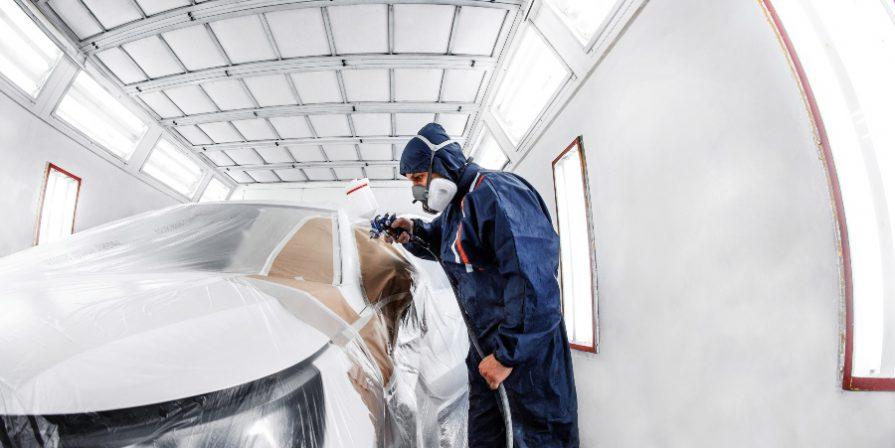« How to Manage Paint Systems Effectively »
The paints used in surface technology change their physical state during processing. The raw materials are in liquid form or are at least flowable so that they can completely cover the surface. During drying, the coating forms a solid film and acquires its final properties. Different processes take place during the drying of single-component paint (1K paint) and two-component paint (2K paint).
Selection of the Paint System
The selection of the coating system depends on the materials intended for coating and the desired properties of the paint layer. Whether 1K or 2K paint is used in surface technology is primarily a question of the intended effect. Products are available for both variants that cover a wide range of resistance to environmental influences and wear, functionality, or decorative effects. However, it should be noted that applying two-component paint requires special attention during the painting process.
Drying Behavior of Paints
The drying behavior of paints plays a crucial role in surface technology. Depending on the paint system, four different drying methods are used:
- Evaporation of the solvent
- Transformation of the binder through reaction with oxygen in the air
- Curing of the paint layer at high temperatures or under UV light (baking enamel, powder coating)
- Chemical reaction between components of the paint at room temperature
The first three methods occur in single-component systems. The paints are processed in their delivered condition. The fourth method requires two components that are mixed shortly before use. One component is the base coating, consisting of a binder, solvent, color pigments, fillers, and additives. The other component is the hardener, which reacts with the binder.
Requirements for Processing 2K Paints
For flawless painting with 2K paints, it is essential to adhere precisely to the mixing ratio between the two components. Since the chemical reaction between the binder and hardener begins immediately after mixing, the paint must be processed quickly. The time frame in which the mixed paint can be used is called the pot life.
The mixing ratio and pot life are specified in the technical data sheets and processing instructions provided by the paint manufacturers.
For small-scale coating tasks with 2K paints, spray cans are available in which the two components are kept separate. The hardener is stored in an inner container, which is opened by a trigger mechanism just before use. This automatically sets the correct mixing ratio. The contents of the spray can must be used within the specified pot life.
Steps in Surface Technology for Painting Processes
Preparation of Surfaces
Regardless of whether 1K or 2K paint is used, thorough surface preparation is necessary. This includes cleaning and drying the surfaces. Metals are often given a conversion coating to improve corrosion resistance and adhesion. Wood surfaces are typically roughened with sandpaper of a specified grit and wiped clean. When processing paints, the manufacturer’s recommendations regarding ambient temperature and humidity must be followed for superior results.
Multi-step Coating Process
The painting process, with few exceptions, is carried out in multiple layers. A primer is applied directly to the surface to ensure proper adhesion. This is usually followed by a base coat, which provides the color. The final layer is a clear coat that protects the base coat from fading due to UV radiation and wear. Each layer must dry before further processing and may need to be sanded. The coating system can consist of 1K or 2K paint or a combination of both. The products used must be compatible with each other, so it is advisable to choose a coating system from a single manufacturer.
In most cases, 1K paint is used for the primer and base coat, and the final clear coat is made of 2K paint.
1K paint that dries by solvent evaporation can be recoated without intermediate sanding. The drying process is reversible, meaning the binder can be dissolved again by the solvent. When recoating a dried layer with a product containing the same solvent, the layers fuse by partially dissolving the lower layer. 2K paint, on the other hand, dries through a chemical reaction, which is irreversible. The binder cannot return to its original state. Therefore, the dry two-component paint must be roughened before recoating to ensure good adhesion between the layers. This also applies to single-component paints that dry through chemical reactions.
Example: Surface Technology in Car Painting
In the automotive industry, surface technology plays a crucial role. The coatings need to withstand environmental exposure and mechanical effects over a long time while maintaining their decorative appeal. Standard car paint consists of four layers. The car bodies and parts are first given a cathodic dip coating, providing comprehensive corrosion protection.
After drying, a thick filler is applied to even out small imperfections and offer some protection against stone chips. It also improves the adhesion of the next layer, the base coat, responsible for the color. The final layer is a colorless clear coat, which protects the entire coating system from UV radiation, abrasion, and aggressive contaminants.
Conclusion Regarding One-Component and Two-Component Coatings
1K and 2K paints differ in their drying methods. In two-component paint, the base coating and hardener react chemically at room temperature. The application requires precise mixing and must be completed within the pot life.
 Kluthe Magazine
Kluthe Magazine







